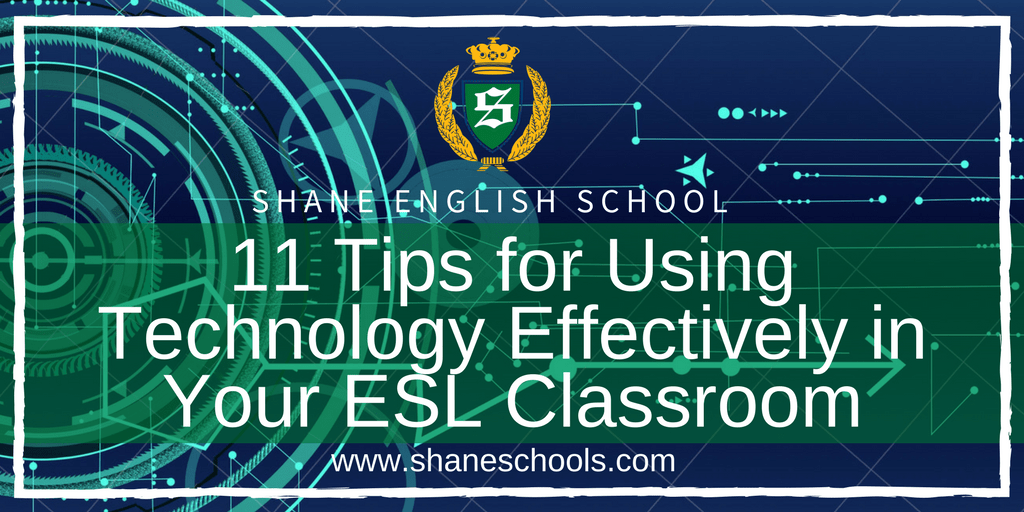Depending on where you teach, technology might be readily available for you to use in your ESL classroom. However, using it effectively, and not just for the sake of using it, is another thing altogether. Some teachers might also be too intimidated to use technology in their classroom and instead sticking to the traditional style of teaching.
Technology, which is a powerful tool, should be used in an ESL class to enhance the lesson and further help students engage with the language.
Read on for 11 tips on how to effectively use technology in your ESL classroom.
1. Film & Video
You can easily use videos (whether they are short films or feature-length) as an engaging way for students to practice vocabulary and comprehension skills. Videos are great to use in your ESL class because it acquaints students with the natural use of English. You can easily make activities to accompany videos that you show in your class; think of fill-in-the-word, complete the sentence, various vocabulary worksheets, and even other writing activities.
2. Podcasts
Listening to podcasts can help ESL students improve comprehension skills and even help them learn new vocabulary words or grammar in context. Furthermore, podcasts can create opportunities for students to practice their speaking skills. Similar to videos, you can create activities and worksheets that complement the podcast(s).
3. Blogs
Setting up blogs is a great way for ESL students to practice their writing skills. There are also several online platforms on which blogs can be created for free. Students generally like writing blogs because it is seen as a more ‘authentic writing experience’ than just writing an essay or story in class. They can also choose a topic or series of themes they like or are passionate about. Additionally, with the potential wider audience reach, students may put more effort into writing their blog.
4. Wiki
Similar in some ways to a blog, you can let your students create a wiki page. The ESL students can easily sign in, add text, edit, and save contributions on this interactive space. A whole class can work together on a topic or each group can create its own wiki.
5. Apps
There are a great variety of apps that teachers can utilise on tables, iPads, and smartphones to make practising English fun for your students. This site lists 16 apps that ESL students can use to practice their English skills. They range from pronunciation and accent practice to building sentences and practising vocabulary and grammar.
6. Online Games
There are various online games available that students can play not only to have fun, but also to practice spelling, grammar, and other ESL skills. There are also digital versions of traditional games such as Hangman, Scrabble, etc. which can be useful and beneficial to the learning process. If you have a smart board in your class, the whole class can play together!
7. Virtual Field Trips
As field trips are not always possible, either due to budgets or maybe the location of the school, virtual field trips are the next best thing as they provide a more genuine way for students to take in new information (see experiential learning).
8. Online Testing Tools
Rather than making tests and/or quizzes the old fashioned way, you can use (free) online testing tools, like this one. Online tests are especially great if all the students in your class have access to an iPad (or tablets) or a computer. Alternatively, you can put a test on the smart board if you want your students to work together as a class or in small groups. This can work really well for a Test Teach Test lesson or even as a review before a big test.
9. Game Show Review
Microsoft PowerPoint (or Mac’s Keynote) is the perfect resource to create review games that are based on game shows, such as “The Weakest Link”, “Who Wants to be a Millionaire”, etc. If you aren’t yet tech savvy enough to create your own templates, you can easily Google “powerpoint game show template” or visit this link for free downloadable templates.
10. Presentations
If your students have access to computers in the classroom, then they can easily research a topic on the Web and make a presentation. Set some clear rules and time limits. For example, there are quite a few voice-recording apps available – tell the students the introduction must be voice recorded and can only be 2 minutes long. Students can then even present their presentations to the whole class, giving them plenty of speaking practice.
11. Online Grading
As we all become more technology dependent, a tool like an online grading system seems perfect; you never have to worry that you forgot your grade book at home. MyGradeBook.com is one such system, and while it is not free, it does have great features in addition to keeping all grades online. This system tracks changes, helps you create a seating chart, and you can even email parents (or students) directly to keep them up to date with their children’s progress.
Conclusion
There is no need to be afraid to use technology in your ESL classroom or to worry about how to use it effectively. These 11 tips are a great start for any teacher and should make you think of even more ways technology can be utilized as a value-add in the class.
What are some effective ways you use technology with your ESL students?
About the Author
Denine Walters is currently a freelance writer, editor/proofreader and ESL teacher. Previously, she taught online English lessons to students from all around the world and, before that, she lived and taught English to young learners in Taiwan. In her free time, she likes to read, do scrapbooking and grammar quizzes, and travel.

We're hiring!
With schools around the world, Shane English School always has exciting new opportunities to offer.


